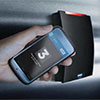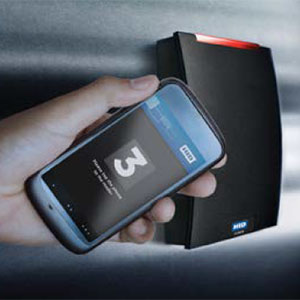
Biometrics on the Move
Smart cards and smartphones make play for access control
- By Dave Adams
- May 01, 2013
 Multiple factors of authentication, including
biometrics, can increase the probability
that a person presenting a card to a
reader is the same person who was initially
issued the card. Biometrics authenticates
identity by measuring and verifying
an individual’s unique physical characteristics,
such as fingerprints, hand and face geometry, or patterns
found in the eye’s iris. Since these identifiers can’t be
borrowed or stolen, biometrics provide identity authentication
with a strong degree of confidence.
Multiple factors of authentication, including
biometrics, can increase the probability
that a person presenting a card to a
reader is the same person who was initially
issued the card. Biometrics authenticates
identity by measuring and verifying
an individual’s unique physical characteristics,
such as fingerprints, hand and face geometry, or patterns
found in the eye’s iris. Since these identifiers can’t be
borrowed or stolen, biometrics provide identity authentication
with a strong degree of confidence.
Until recently, biometric templates, such as those for iris recognition,
were carried on a plastic credential and presented for
authentication by holding the card in front of an iris recognition
camera. Now, these same templates can be loaded onto an NFCenabled
smartphone along with other digital ID credentials for
physical and logical access control.
Going Mobile
Several trends are driving the adoption of physical and logical
access control on smartphones and other mobile devices. The
first is the inclusion of NFC technology on smartphones, which
provides an industry-standard, short-range wireless link for exchanging
access-control data across a several centimeter distance
so users can “present” credentials on phones to a reader. As the
NFC mobile-payment model grows in popularity, it drives further
demand for NFC phones which also can be used in physical
access control applications. Smartphones that do not feature
NFC technology can be securely upgraded to this capability by
using an NFC-enabled add-on device such as a microSD card.
Additionally, there is now a new type of identity representation
that operates within a trusted boundary and uses the NFCenabled
smartphone’s secure element or SIM—usually an embedded
tamper-proof integrated circuit, or a plug-in module version.
This setup ensures that all transactions between NFC-enabled
smartphones, SIM cards and other secure media devices also can
be trusted inside the access-control managed network.
Within this trusted boundary, organizations can provide mobile
access-control credentials in either of two secure and convenient
ways: Connecting the mobile device to the network via a
USB or Wi-Fi-enabled link and use an Internet portal, similar to
how traditional plastic credentials are provisioned, or issue digital
credentials over-the-air via a mobile network operator, in much
the same way that today’s smartphone users download apps and
songs. To issue digital credentials, the NFC-enabled smartphone
communicates with a Trusted Service Manager (TSM), which interfaces
either directly to the mobile network operator (MNO) or
to its TSM, delivering a key to the SIM card.
The mobile access model offers a number of benefits. It eliminates
credential copying, and makes it easier to issue temporary
credentials as needed, cancel credentials if a device is lost or stolen,
and monitor and modify security parameters when required.
The mobile model is ideal for converged physical and logical access,
enabling smartphones to be used for multiple applications
including cashless vending; opening residential locks; accessing
an on-line physical access-control reader; entering a building protected
by an NFC-enabled electromechanical lock; logging on to
a PC; generating OTP software tokens to log onto network devices;
and implementing biometric authentication.
How Biometrics Work
Biometrics verify that a card holder has been bound to his or her
card, using something that can only be possessed by the person
to whom the card was issued. Biometric data is unique to each
person and cannot be forgotten, lost or stolen. Because of this,
biometric technology offers enhanced security when compared with conventional identification methods.
It does not rely on passwords, pin codes
or photographic ID, and is too complex
to forge. Biometrics are generally used as
part of a verification system, which checks
a biometric that has been presented by
an individual against the biometric in a
database linked to that person’s file—a
one-to-one system, or an identification
system—referred to as one-to-many systems
because they are used to identify an
unknown person or biometric.
Biometrics has long been used by the
government, and is a key element of the
latest federal identity standards. For instance,
the Department of Defense (DoD)
has incorporated biometrics into the common
access card (CAC) that controls entry
to DoD facilities and information systems.
Biometrics is an integral part of the latest
identity credentials for federal agency
employees and contractors. In 2005, the
National Institute of Standards and Technology
(NIST) released Federal Information
Processing Standards Publication
201 (FIPS 201), which defined the identity
vetting, enrollment and issuance requirements
for a common, highly-secure identity
credential called the Personal Identity
Verification (PIV) card that leverages both
smart card and biometric technology. In
2006, FIPS 201-1 further specified that a
facial image, as well as fingerprint biometrics,
be included on PIV cards.
On NFC Smartphones
The same benefits associated with storing
biometric templates on physical smart
cards also apply to the mobile accesscontrol
model. Next-generation mobile
access platforms enable users to implement
biometrics templates similar to traditional
physical credential implementation
while offering the added benefits of
being able to carry the credentials in their
smartphones. For instance, a smartphone
can carry credentials that securely store
biometric templates, such as those for iris
recognition. To present these credentials
for authentication, the user simply holds
the smartphone in front of an iris recognition
camera. A variety of biometric
templates can be securely stored in these
digital credentials.
The smartphone offers a portable database
for template storage well suited
for installations that span a large number
of sites. Storing the template on a digital
NFC smartphone credential also simplifies
system start-up, and is ideal for supporting
unlimited user populations. It
reduces installation costs by eliminating
the redundant wiring requirements for
traditional biometric template management
on plastic cards. And, because an
access-control system can continuously
read the biometrics data carried inside a
smartphone, this model enables pre-authentication
before someone even arrives
at a door, speeding and simplifying each
access transaction.
Another advantage of mobile access
control is simplification in deployment
and management of biometric security
and other multi-factor authentication applications.
When a situation arises that
requires a higher level of security, organizations
can dynamically invoke two-factor
authentication. To do this, an application
can be pushed to the phone that, for instance,
requires the user to enter a 4-digit
pin, perform a gesture swipe on the phone
or present biometric data within the phone
to a reader before it sends the message to
open the door. With this approach, multifactor
authentication becomes a contextual,
real-time, managed service.
Latest Developments
HID Global is partnering with a number
of leaders in the biometric space to
deliver HID-enabled credential solutions
that support biometrics, enabling users to
securely store a wide variety of biometric
templates. An alternative to storing the
biometric template on the card is to store
them in the reader, on servers, and/or in
individual panels. This would be necessary
for users of proximity or magnetic stripe
cards that are unable to store the template.
The next step is to deploy biometrics
on NFC-enabled smartphones, as well.
In March 2012, Iris ID Systems Inc. announced
interoperability between its
IrisAccess platform and NFC-enabled
BlackBerry smartphones equipped with
HID Global’s iCLASS digital credentials.
This means that BlackBerry Bold
9900/9930 smartphones activated with
HID Global’s iCLASS digital credentials
are interoperable with the installed base
of iCLASS readers that are embedded in
the Iris iCAM 7000 series for applications
ranging from physical access systems in
buildings, to systems that track time and
attendance, to other identity-dependent
solutions. Using an NFC-enabled Black-
Berry smartphone, the iris templates of
a user are securely stored on an iCLASS
digital credential on the phone. This credential
can then be presented for authentication
by simply holding the NFC-enabled
BlackBerry smartphone in front of an
iCAM7000 series iris camera, in the same
way that users present physical iCLASS
smart cards to these readers.
Biometrics continue to be an important
element in access-control systems that use
multi-factor authentication for the highest
levels of security. The latest solutions
can be deployed on a combination of traditional
plastic ID cards or NFC-enabled
smartphones, for a variety of commercial
and government applications. The mobile
access-control model using smartphones is
particularly compelling, and is enabled by
NFC technology and a new access-control
data structure that operates in a trusted
boundary to significantly improve overall
system security and user convenience. This
offers an ideal platform for converged physical
and logical access that includes biometric
technology for identity authentication.
This article originally appeared in the May 2013 issue of Security Today.